fuses Mercury Sable 2005 Owner's Manuals
[x] Cancel search | Manufacturer: MERCURY, Model Year: 2005, Model line: Sable, Model: Mercury Sable 2005Pages: 248, PDF Size: 2.46 MB
Page 2 of 248
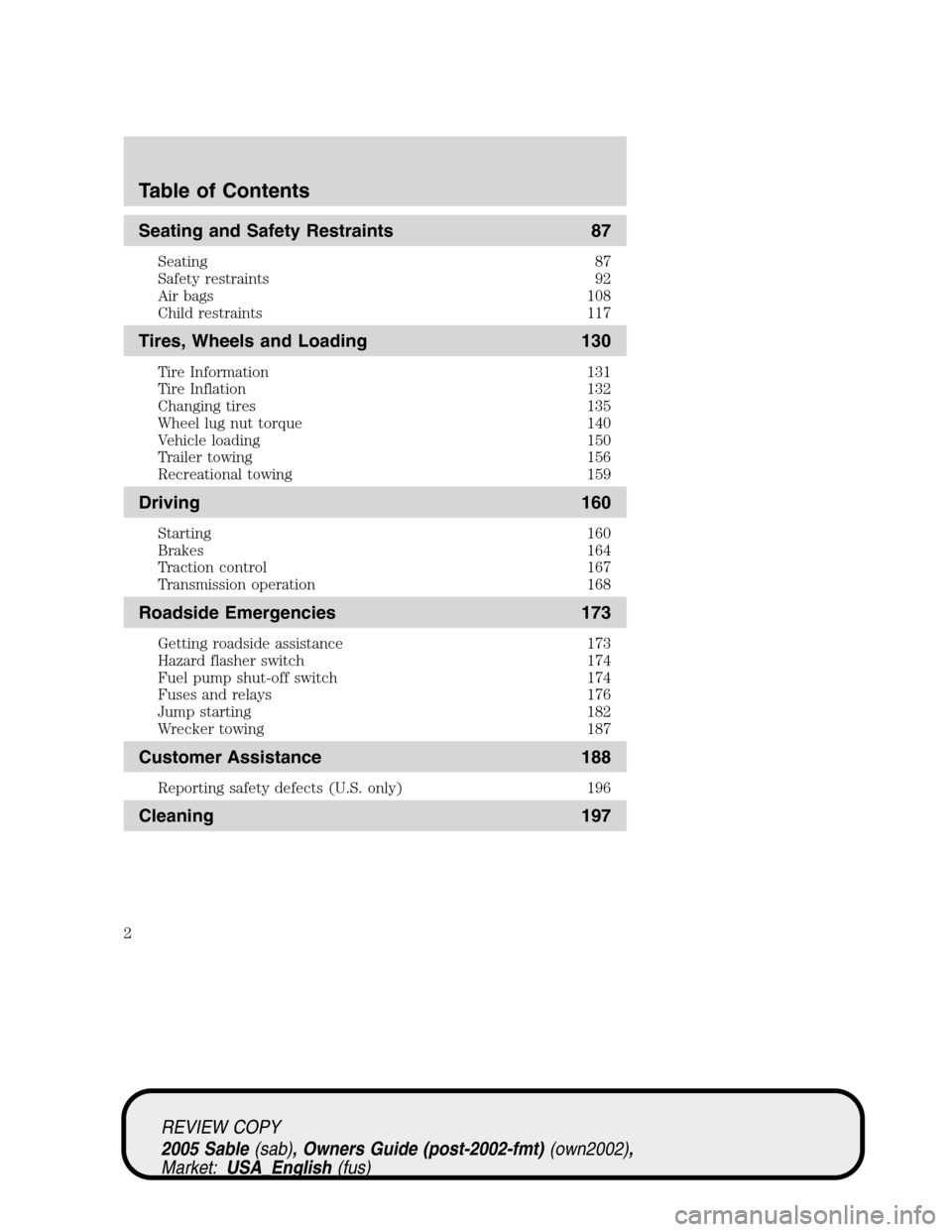
Seating and Safety Restraints 87
Seating 87
Safety restraints 92
Air bags 108
Child restraints 117
Tires, Wheels and Loading 130
Tire Information 131
Tire Inflation 132
Changing tires 135
Wheel lug nut torque 140
Vehicle loading 150
Trailer towing 156
Recreational towing 159
Driving 160
Starting 160
Brakes 164
Traction control 167
Transmission operation 168
Roadside Emergencies 173
Getting roadside assistance 173
Hazard flasher switch 174
Fuel pump shut-off switch 174
Fuses and relays 176
Jump starting 182
Wrecker towing 187
Customer Assistance 188
Reporting safety defects (U.S. only) 196
Cleaning 197
Table of Contents
2
REVIEW COPY
2005 Sable(sab), Owners Guide (post-2002-fmt)(own2002),
Market:USA_English(fus)
Page 110 of 248
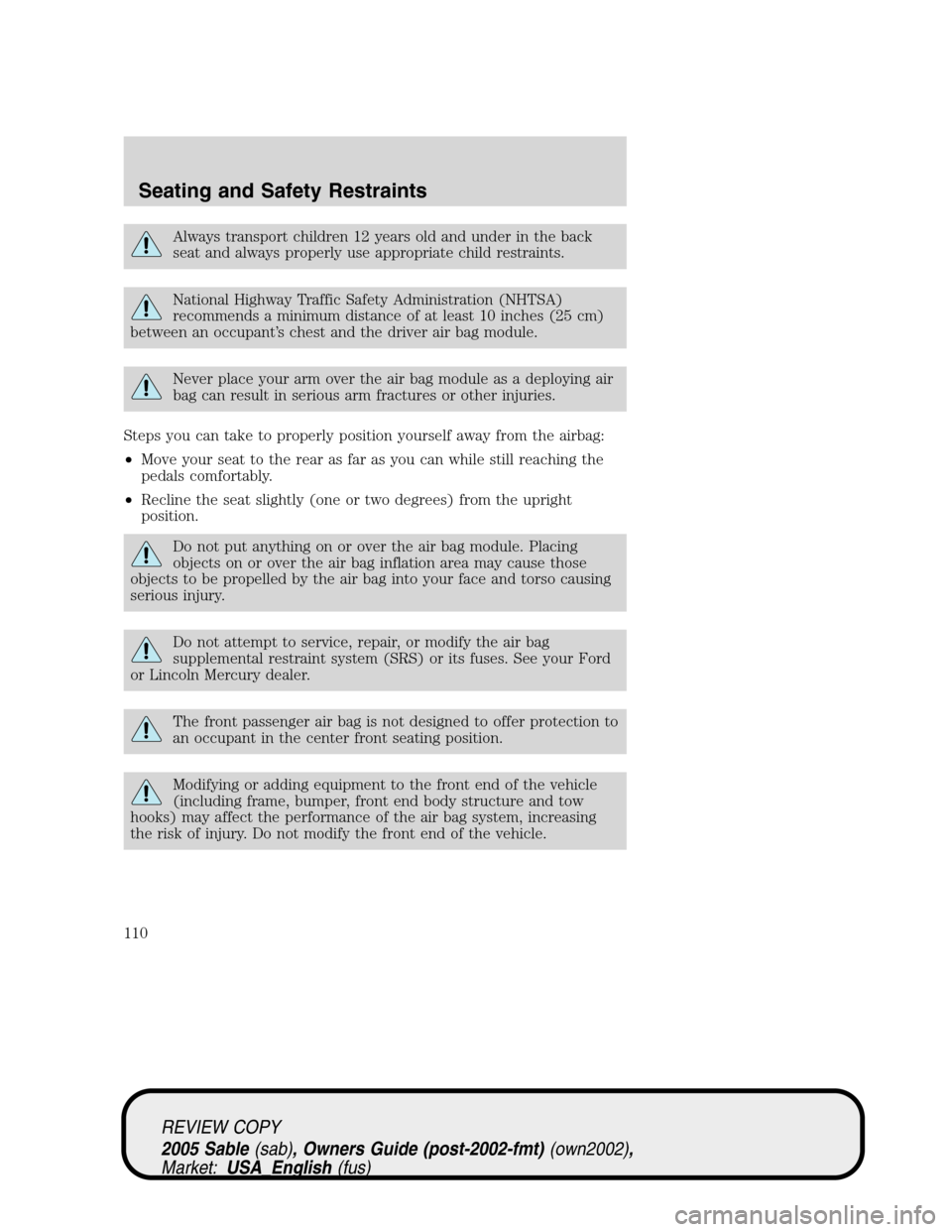
Always transport children 12 years old and under in the back
seat and always properly use appropriate child restraints.
National Highway Traffic Safety Administration (NHTSA)
recommends a minimum distance of at least 10 inches (25 cm)
between an occupant’s chest and the driver air bag module.
Never place your arm over the air bag module as a deploying air
bag can result in serious arm fractures or other injuries.
Steps you can take to properly position yourself away from the airbag:
•Move your seat to the rear as far as you can while still reaching the
pedals comfortably.
•Recline the seat slightly (one or two degrees) from the upright
position.
Do not put anything on or over the air bag module. Placing
objects on or over the air bag inflation area may cause those
objects to be propelled by the air bag into your face and torso causing
serious injury.
Do not attempt to service, repair, or modify the air bag
supplemental restraint system (SRS) or its fuses. See your Ford
or Lincoln Mercury dealer.
The front passenger air bag is not designed to offer protection to
an occupant in the center front seating position.
Modifying or adding equipment to the front end of the vehicle
(including frame, bumper, front end body structure and tow
hooks) may affect the performance of the air bag system, increasing
the risk of injury. Do not modify the front end of the vehicle.
REVIEW COPY
2005 Sable(sab), Owners Guide (post-2002-fmt)(own2002),
Market:USA_English(fus)
Seating and Safety Restraints
110
Page 116 of 248

Do not use accessory seat covers. The use of accessory seat
covers may prevent the deployment of the side air bags and
increase the risk of injury in an accident.
Do not lean your head on the door. The side air bag could injure
you as it deploys from the side of the seatback.
Do not attempt to service, repair, or modify the air bag SRS, its
fuses or the seat cover on a seat containing an air bag. See your
Ford or Lincoln Mercury dealer.
All occupants of the vehicle should always wear their safety belts
even when an air bag SRS is provided.
How does the side air bag system work?
The side air bag system consists of
the following:
• An inflatable nylon bag (air bag)
with a gas generator concealed
behind the outboard bolster of
the driver and front passenger
seatbacks.
• A special seat cover designed to
allow air bag deployment.
• The same warning light,
electronic control and diagnostic unit as used for the front air bags.
• Two crash sensors located on the pillars between the front and rear
doors (one on each side of the vehicle).
Side air bags, in combination with seat belts, can help reduce the risk of
severe injuries in the event of a significant side impact collision.
The side air bags are fitted on the outboard side of the seatbacks of the
front seats. In certain lateral collisions, the air bag on the side affected
by the collision will be inflated, even if the respective seat is not
occupied. The air bag was designed to inflate between the door panel
and occupant to further enhance the protection provided occupants in
side impact collisions.
REVIEW COPY
2005 Sable (sab), Owners Guide (post-2002-fmt) (own2002),
Market: USA_English (fus)
Seating and Safety Restraints
116
Page 169 of 248
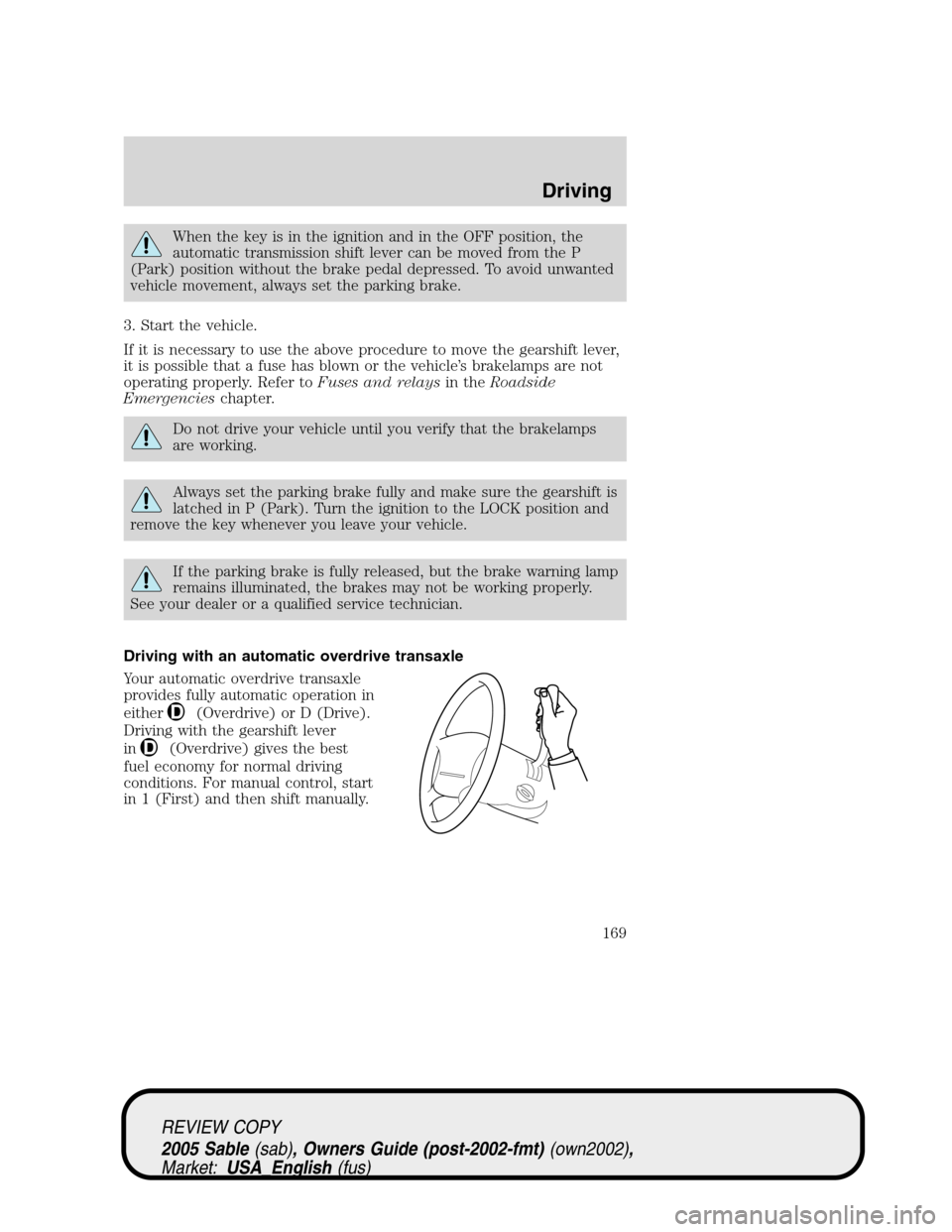
When the key is in the ignition and in the OFF position, the
automatic transmission shift lever can be moved from the P
(Park) position without the brake pedal depressed. To avoid unwanted
vehicle movement, always set the parking brake.
3. Start the vehicle.
If it is necessary to use the above procedure to move the gearshift lever,
it is possible that a fuse has blown or the vehicle’s brakelamps are not
operating properly. Refer toFuses and relaysin theRoadside
Emergencieschapter.
Do not drive your vehicle until you verify that the brakelamps
are working.
Always set the parking brake fully and make sure the gearshift is
latched in P (Park). Turn the ignition to the LOCK position and
remove the key whenever you leave your vehicle.
If the parking brake is fully released, but the brake warning lamp
remains illuminated, the brakes may not be working properly.
See your dealer or a qualified service technician.
Driving with an automatic overdrive transaxle
Your automatic overdrive transaxle
provides fully automatic operation in
either
(Overdrive) or D (Drive).
Driving with the gearshift lever
in
(Overdrive) gives the best
fuel economy for normal driving
conditions. For manual control, start
in 1 (First) and then shift manually.
REVIEW COPY
2005 Sable(sab), Owners Guide (post-2002-fmt)(own2002),
Market:USA_English(fus)
Driving
169
Page 176 of 248

FUSES
If electrical components in the
vehicle are not working, a fuse may
have blown. Blown fuses are
identified by a broken wire within
the fuse. Check the appropriate
fuses before replacing any electrical
components.
Note:Always replace a fuse with one that has the specified amperage
rating. Using a fuse with a higher amperage rating can cause severe wire
damage and could start a fire.
Standard fuse amperage rating and color
COLOR
Fuse
ratingMini
fusesStandard
fusesMaxi
fusesCartridge
Maxi
fusesFuse link
cartridge
2A Grey Grey———
3A Violet Violet———
4A Pink Pink———
5A Tan Tan———
7.5A Brown Brown———
10A Red Red———
15A Blue Blue———
20A Yellow Yellow Yellow Blue Blue
25A Natural Natural———
30A Green Green Green Pink Pink
40A——Amber Green Green
50A——Red Red Red
60A——Blue—Yellow
70A——Ta n—Brown
80A——Natural—Black
Passenger compartment fuse panel
The fuse panel is located below and to the left of the steering wheel by
the brake pedal. Remove the panel cover to access the fuses.
15
REVIEW COPY
2005 Sable(sab), Owners Guide (post-2002-fmt)(own2002),
Market:USA_English(fus)
Roadside Emergencies
176
Page 177 of 248
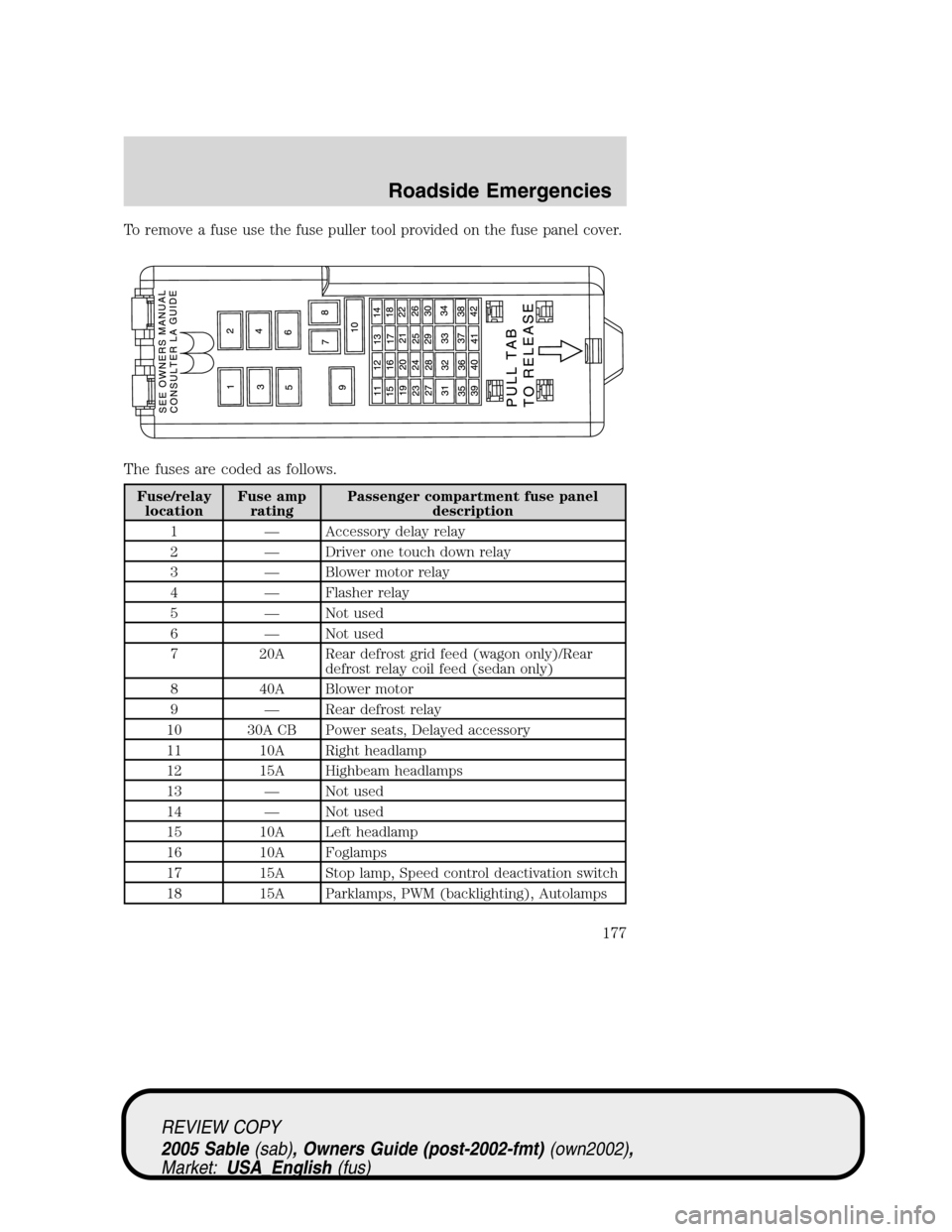
To remove a fuse use the fuse puller tool provided on the fuse panel cover.
The fuses are coded as follows.
Fuse/relay
locationFuse amp
ratingPassenger compartment fuse panel
description
1—Accessory delay relay
2—Driver one touch down relay
3—Blower motor relay
4—Flasher relay
5—Not used
6—Not used
7 20A Rear defrost grid feed (wagon only)/Rear
defrost relay coil feed (sedan only)
8 40A Blower motor
9—Rear defrost relay
10 30A CB Power seats, Delayed accessory
11 10A Right headlamp
12 15A Highbeam headlamps
13—Not used
14—Not used
15 10A Left headlamp
16 10A Foglamps
17 15A Stop lamp, Speed control deactivation switch
18 15A Parklamps, PWM (backlighting), Autolamps
REVIEW COPY
2005 Sable(sab), Owners Guide (post-2002-fmt)(own2002),
Market:USA_English(fus)
Roadside Emergencies
177
Page 179 of 248

Fuse/relay
locationFuse amp
ratingPassenger compartment fuse panel
description
37 25A Autolamp, Daytime Running Lamps (DRL),
Flash-to-pass, Headlamp switch
38 15A Horn, Diagnostic connector (OBD II)
39—Not used
40—Not used
41—Not used
42—Not used
CB - Circuit Breaker
Power distribution box
The power distribution box is
located in the engine compartment.
The power distribution box contains
high-current fuses that protect your
vehicle’s main electrical systems
from overloads.
Always disconnect the battery before servicing high current
fuses.
To reduce risk of electrical shock, always replace the cover to
the Power Distribution Box before reconnecting the battery or
refilling fluid reservoirs.
If the battery has been disconnected and reconnected, refer to the
Batterysection of theMaintenance and Specificationschapter.
REVIEW COPY
2005 Sable(sab), Owners Guide (post-2002-fmt)(own2002),
Market:USA_English(fus)
Roadside Emergencies
179
Page 180 of 248
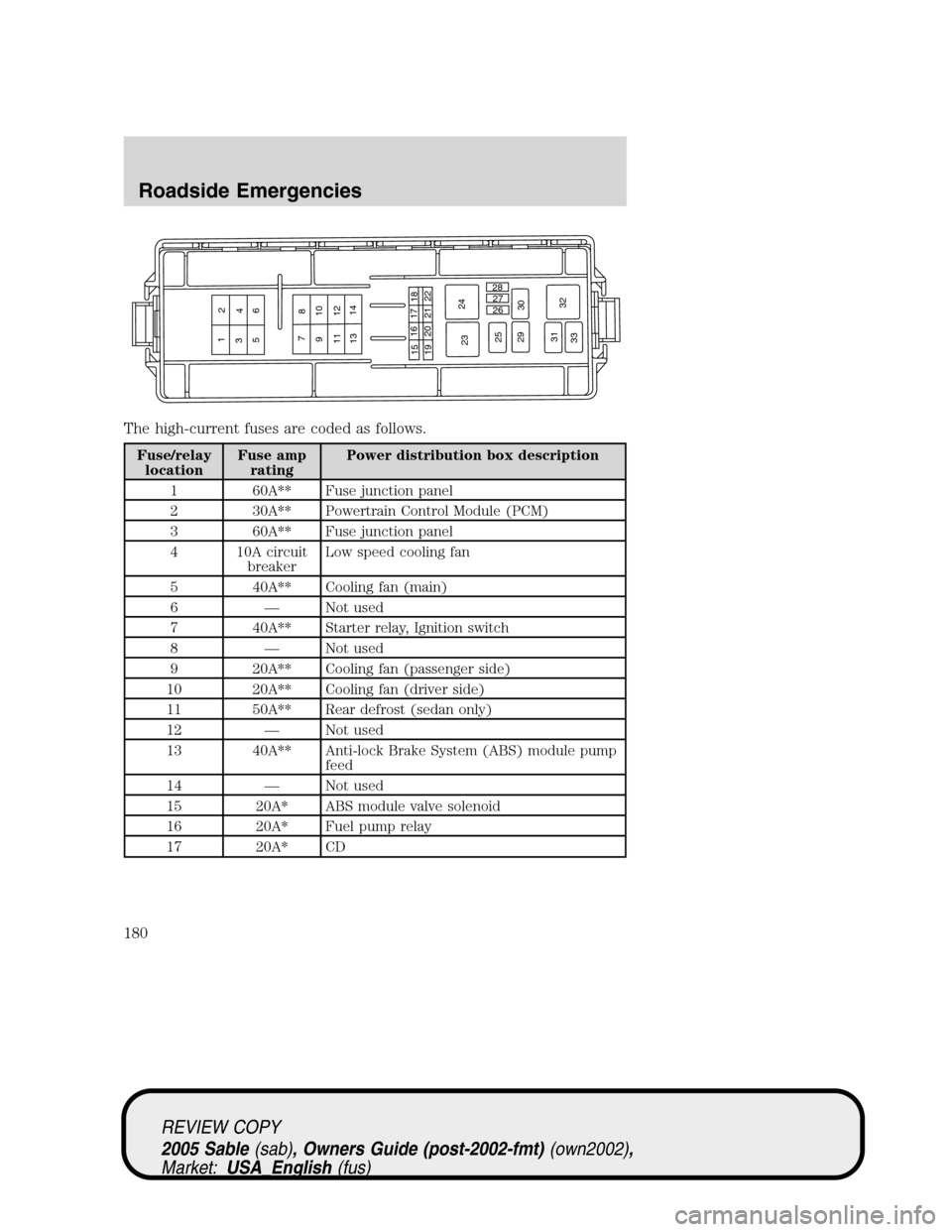
The high-current fuses are coded as follows.
Fuse/relay
locationFuse amp
ratingPower distribution box description
1 60A** Fuse junction panel
2 30A** Powertrain Control Module (PCM)
3 60A** Fuse junction panel
4 10A circuit
breakerLow speed cooling fan
5 40A** Cooling fan (main)
6—Not used
7 40A** Starter relay, Ignition switch
8—Not used
9 20A** Cooling fan (passenger side)
10 20A** Cooling fan (driver side)
11 50A** Rear defrost (sedan only)
12—Not used
13 40A** Anti-lock Brake System (ABS) module pump
feed
14—Not used
15 20A* ABS module valve solenoid
16 20A* Fuel pump relay
17 20A* CD
1
23
4
56
7
8
910
11 12
1314
1516 17
18
19202122
2324
25
29
3026 27 28
31
32
33
REVIEW COPY
2005 Sable(sab), Owners Guide (post-2002-fmt)(own2002),
Market:USA_English(fus)
Roadside Emergencies
180
Page 181 of 248
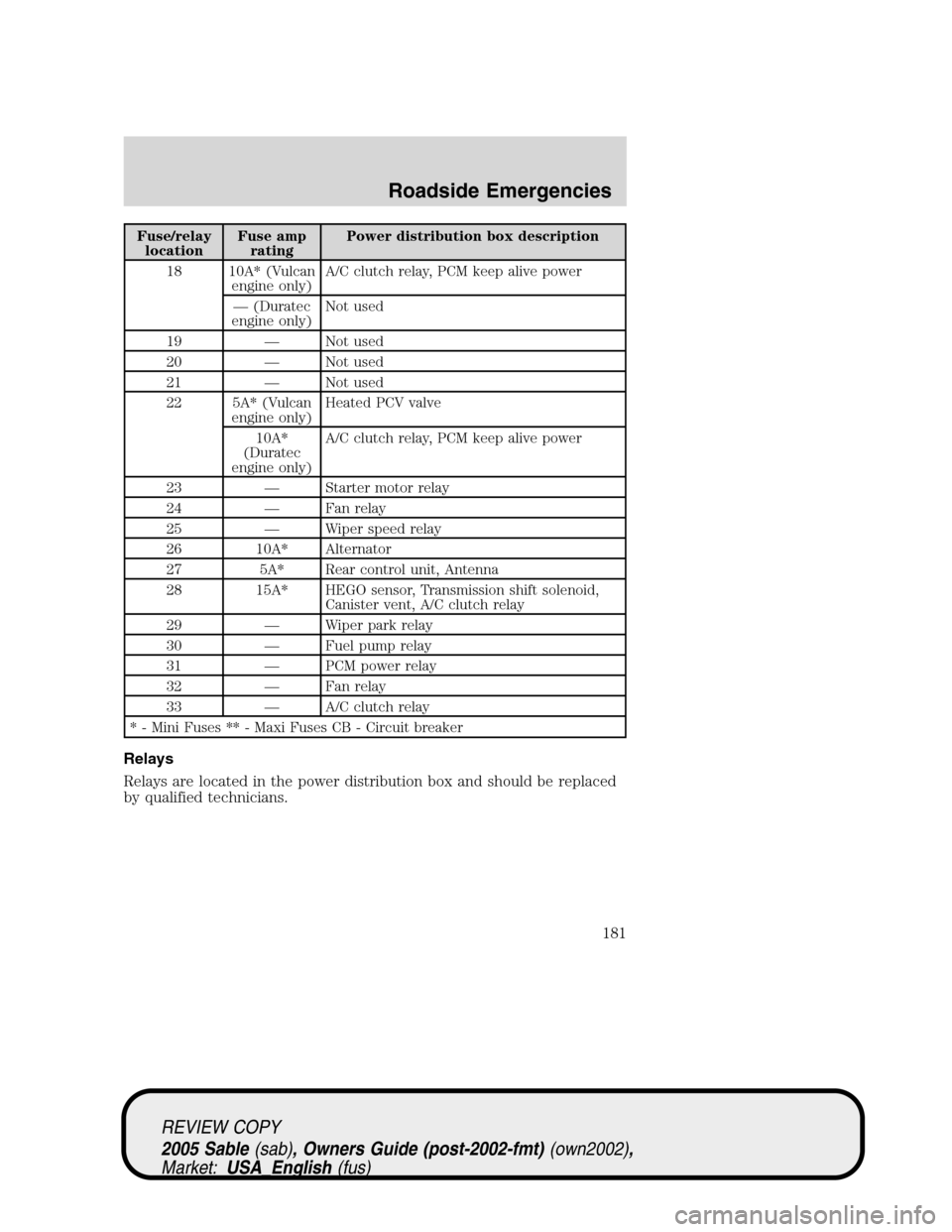
Fuse/relay
locationFuse amp
ratingPower distribution box description
18 10A* (Vulcan
engine only)A/C clutch relay, PCM keep alive power
—(Duratec
engine only)Not used
19—Not used
20—Not used
21—Not used
22 5A* (Vulcan
engine only)Heated PCV valve
10A*
(Duratec
engine only)A/C clutch relay, PCM keep alive power
23—Starter motor relay
24—Fan relay
25—Wiper speed relay
26 10A* Alternator
27 5A* Rear control unit, Antenna
28 15A* HEGO sensor, Transmission shift solenoid,
Canister vent, A/C clutch relay
29—Wiper park relay
30—Fuel pump relay
31—PCM power relay
32—Fan relay
33—A/C clutch relay
* - Mini Fuses ** - Maxi Fuses CB - Circuit breaker
Relays
Relays are located in the power distribution box and should be replaced
by qualified technicians.
REVIEW COPY
2005 Sable(sab), Owners Guide (post-2002-fmt)(own2002),
Market:USA_English(fus)
Roadside Emergencies
181
Page 245 of 248
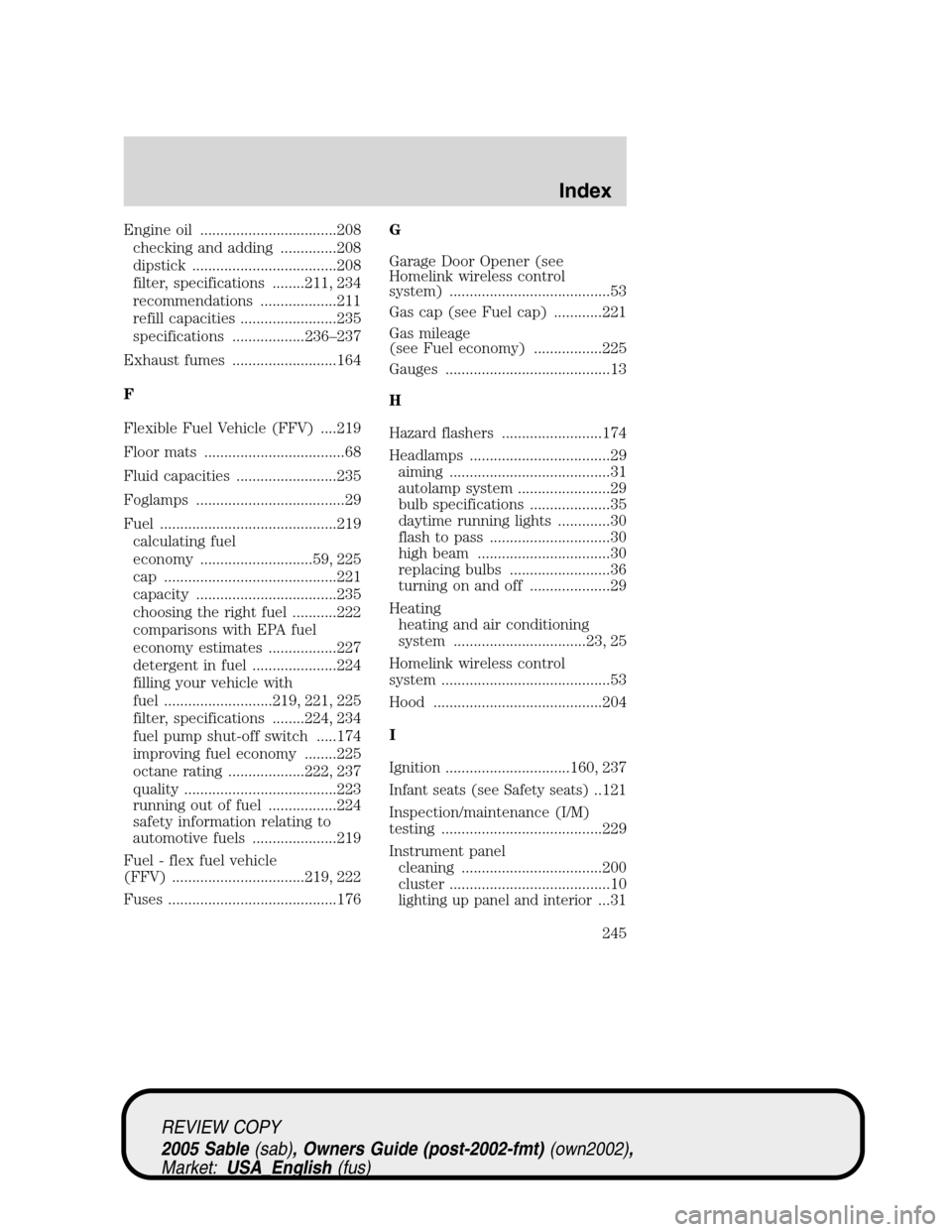
Engine oil ..................................208
checking and adding ..............208
dipstick ....................................208
filter, specifications ........211, 234
recommendations ...................211
refill capacities ........................235
specifications ..................236–237
Exhaust fumes ..........................164
F
Flexible Fuel Vehicle (FFV) ....219
Floor mats ...................................68
Fluid capacities .........................235
Foglamps .....................................29
Fuel ............................................219
calculating fuel
economy ............................59, 225
cap ...........................................221
capacity ...................................235
choosing the right fuel ...........222
comparisons with EPA fuel
economy estimates .................227
detergent in fuel .....................224
filling your vehicle with
fuel ...........................219, 221, 225
filter, specifications ........224, 234
fuel pump shut-off switch .....174
improving fuel economy ........225
octane rating ...................222, 237
quality ......................................223
running out of fuel .................224
safety information relating to
automotive fuels .....................219
Fuel - flex fuel vehicle
(FFV) .................................219, 222
Fuses ..........................................176G
Garage Door Opener (see
Homelink wireless control
system) ........................................53
Gas cap (see Fuel cap) ............221
Gas mileage
(see Fuel economy) .................225
Gauges .........................................13
H
Hazard flashers .........................174
Headlamps ...................................29
aiming ........................................31
autolamp system .......................29
bulb specifications ....................35
daytime running lights .............30
flash to pass ..............................30
high beam .................................30
replacing bulbs .........................36
turning on and off ....................29
Heating
heating and air conditioning
system .................................23, 25
Homelink wireless control
system ..........................................53
Hood ..........................................204
I
Ignition ...............................160, 237
Infant seats (see Safety seats)..121
Inspection/maintenance (I/M)
testing ........................................229
Instrument panel
cleaning ...................................200
cluster ........................................10
lighting up panel and interior...31
REVIEW COPY
2005 Sable(sab), Owners Guide (post-2002-fmt)(own2002),
Market:USA_English(fus)
Index
245